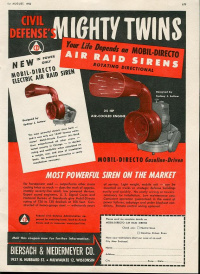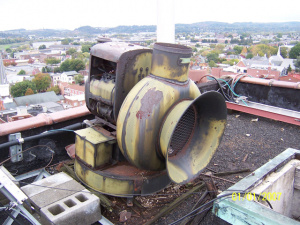BNCO Mobil Directo: Difference between revisions
(Added a photo of a Gas MD, and added what kind of engine it had.) |
No edit summary |
||
| Line 1: | Line 1: | ||
{{Infobox siren | {{Infobox siren | ||
|image=[[File:Mobil20directo20ad20195220sm.jpg|200px]] | |image=[[File:Mobil20directo20ad20195220sm.jpg|200px]] | ||
|produced= | |produced= 1942-1967 | ||
|company= Biersach & Niedermeyer Co. | |company= Biersach & Niedermeyer Co. | ||
|type= [[Electromechanical]] | |type= [[Electromechanical]] | ||
| Line 8: | Line 8: | ||
}} | }} | ||
=General= | |||
The Mobil Directo was a siren produced by the Biersach and Niedermeyer Company from 1942 to 1967. The siren would be offered in two variants, the gasoline-engine driven BN44 and the electric-motor driven BN44E. | |||
The | ==BN44== | ||
After the Pearl Harbor attack in 1942, the United States Department of the Army volunteered the Biersach and Niedermeyer Company of Milwaukee, WI to begin production of warning sirens and siren controls. The immediate result of this was the BN44. Commonly known as the Mobil Directo, the BN44 used a 25 horsepower, air-cooled, gasoline engine to drive the rotor/stator assembly while also rotating the entire assembly. The projector design was unique, as air would be drawn in to the front of the siren through a "bowl" shaped protrusion, and the resulting sound would be forced from the top of the chopper up through a triangular, horn-like projector. Using this method, the siren boasted a 125 decibel rating at 100 feet. The gasoline-driven nature of the siren allowed it to be deployed in otherwise inefficient circumstances. For this reason, the BN44 saw widespread use throughout the Pacific Theater on remote island air bases. Additionally, the siren would be installed in several locations throughout the United States. In all, more than 2000 units would be sold. | |||
==BN44E== | |||
As time went on, it became evident that a gasoline driven siren was not efficient as a permanent installation, and in 1948 Biersach and Niedermeyer Company introduced the BN44E. The BN44E retained the same sound producing components of the BN44 while replacing the gasoline engine with a 10 horsepower electric motor. The BN44 and BN44E would be offered alongside each other until 1953, when the BN44 was discontinued. A three-signal model of the BN44E, the BN44E-MS-3, would also be offered. Additionally, many original BN44 sirens would undergo a coversion from gasoline to electric. The BN44E was offered up until 1967, when it was discontinued in favor of the Alerting Communicators of America Allertor. | |||
[[File:York.jpg|thumb| a Mobil-Directo that still retains its original gasoline engine. The engine was an air cooled Wisconsin 25HP V-4 engine. ]] | [[File:York.jpg|thumb| a Mobil-Directo that still retains its original gasoline engine. The engine was an air cooled Wisconsin 25HP V-4 engine. ]] | ||
Revision as of 21:09, 17 November 2019
| BNCO Mobil Directo | |
[[File: |200px]] |200px]]
| |
| Company | Biersach & Niedermeyer Co. |
|---|---|
| Produced | 1942-1967 |
| Type | Electromechanical |
| Sound output | 125 |
| Succeeded by | Allertor 125 |
General
The Mobil Directo was a siren produced by the Biersach and Niedermeyer Company from 1942 to 1967. The siren would be offered in two variants, the gasoline-engine driven BN44 and the electric-motor driven BN44E.
BN44
After the Pearl Harbor attack in 1942, the United States Department of the Army volunteered the Biersach and Niedermeyer Company of Milwaukee, WI to begin production of warning sirens and siren controls. The immediate result of this was the BN44. Commonly known as the Mobil Directo, the BN44 used a 25 horsepower, air-cooled, gasoline engine to drive the rotor/stator assembly while also rotating the entire assembly. The projector design was unique, as air would be drawn in to the front of the siren through a "bowl" shaped protrusion, and the resulting sound would be forced from the top of the chopper up through a triangular, horn-like projector. Using this method, the siren boasted a 125 decibel rating at 100 feet. The gasoline-driven nature of the siren allowed it to be deployed in otherwise inefficient circumstances. For this reason, the BN44 saw widespread use throughout the Pacific Theater on remote island air bases. Additionally, the siren would be installed in several locations throughout the United States. In all, more than 2000 units would be sold.
BN44E
As time went on, it became evident that a gasoline driven siren was not efficient as a permanent installation, and in 1948 Biersach and Niedermeyer Company introduced the BN44E. The BN44E retained the same sound producing components of the BN44 while replacing the gasoline engine with a 10 horsepower electric motor. The BN44 and BN44E would be offered alongside each other until 1953, when the BN44 was discontinued. A three-signal model of the BN44E, the BN44E-MS-3, would also be offered. Additionally, many original BN44 sirens would undergo a coversion from gasoline to electric. The BN44E was offered up until 1967, when it was discontinued in favor of the Alerting Communicators of America Allertor.
